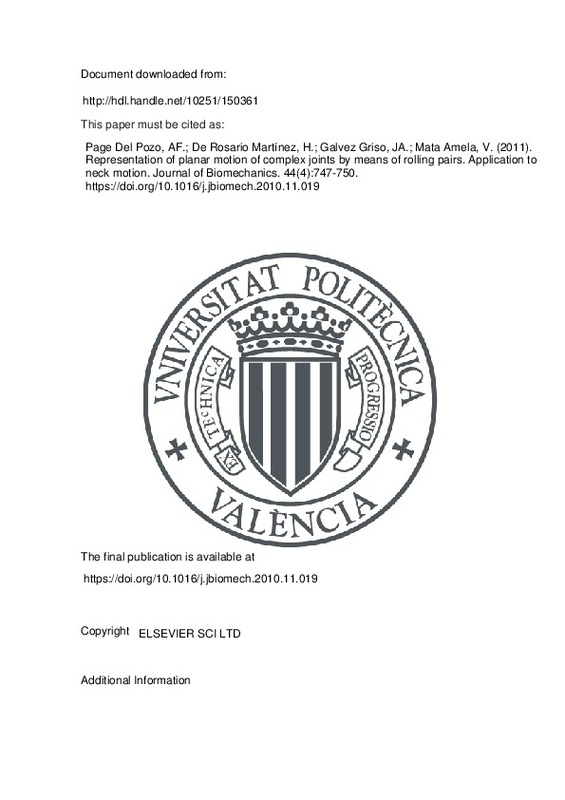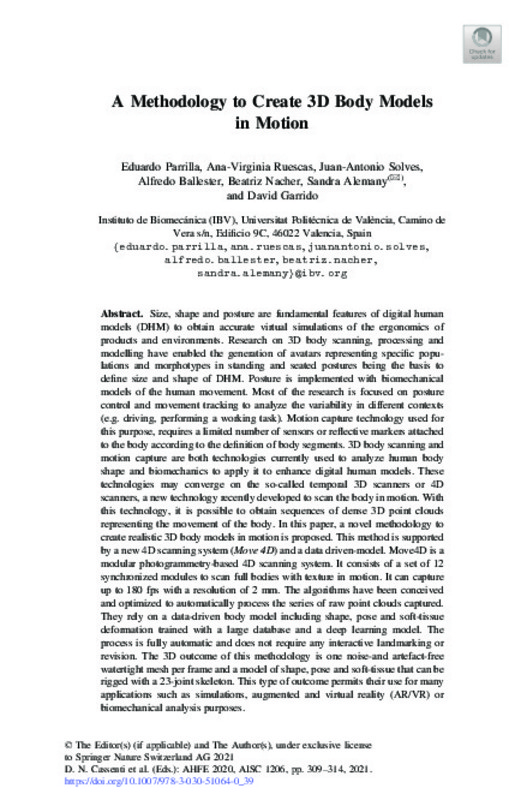Page Del Pozo, AF.; De Rosario Martínez, H.; Galvez Griso, JA.; Mata Amela, V. (2011). Representation of planar motion of complex joints by means of rolling pairs. Application to neck motion. Journal of Biomechanics. 44(4):747-750. https://doi.org/10.1016/j.jbiomech.2010.11.019
Por favor, use este identificador para citar o enlazar este ítem: http://hdl.handle.net/10251/150361
|
Título:
|
Representation of planar motion of complex joints by means of rolling pairs. Application to neck motion
|
|
Autor:
|

 Page Del Pozo, Alvaro Felipe
De Rosario Martínez, Helios
Galvez Griso, Jose Antonio
Page Del Pozo, Alvaro Felipe
De Rosario Martínez, Helios
Galvez Griso, Jose Antonio

 Mata Amela, Vicente
Mata Amela, Vicente
|
|
Entidad UPV:
|
Universitat Politècnica de València. Departamento de Física Aplicada - Departament de Física Aplicada
Universitat Politècnica de València. Departamento de Ingeniería Mecánica y de Materiales - Departament d'Enginyeria Mecànica i de Materials
Universitat Politècnica de València. Instituto Universitario Mixto de Biomecánica de Valencia - Institut Universitari Mixt de Biomecànica de València
|
|
Fecha difusión:
|
|
|
Resumen:
|
[EN] We propose to model planar movements between two human segments by means of rolling-without-slipping kinematic pairs. We compute the path traced by the instantaneous center of rotation (ICR) as seen from the proximal ...[+]
[EN] We propose to model planar movements between two human segments by means of rolling-without-slipping kinematic pairs. We compute the path traced by the instantaneous center of rotation (ICR) as seen from the proximal and distal segments, thus obtaining the fixed and moving centrodes, respectively. The joint motion is then represented by the rolling-without-slipping of one centrode on the other. The resulting joint kinematic model is based on the real movement and accounts for nonfixed axes of rotation; therefore it could improve current models based on revolute pairs in those cases where joint movement implies displacement of the ICR. Previous authors have used the ICR to characterize human joint motion, but they only considered the fixed centrode. Such an approach is not adequate for reproducing motion because the fixed centrode by itself does not convey information about body position. The combination of the fixed and moving centrodes gathers the kinematic information needed to reproduce the position and velocities of moving bodies. To illustrate our method, we applied it to the flexion-extension movement of the head relative to the thorax. The model provides a good estimation of motion both for position variables (mean R pos=0.995) and for velocities (mean R vel=0.958). This approach is more realistic than other models of neck motion based on revolute pairs, such as the dual-pivot model. The geometry of the centrodes can provide some information about the nature of the movement. For instance, the ascending and descending curves of the fixed centrode suggest a sequential movement of the cervical vertebrae. © 2010 Elsevier Ltd.
[-]
|
|
Palabras clave:
|
Human movement
,
Instantaneous helical axis
,
Kinematic analysis
,
Motion modeling
,
Stereophotogrammetry
,
Human movements
,
Photogrammetry
,
Rotation
,
Kinematics
,
Adult
,
Article
,
Biomechanics
,
Cervical spine
,
Controlled study
,
Female
,
Head movement
,
Human
,
Human experiment
,
Joint function
,
Male
,
Normal human
,
Planar motion
,
Priority journal
,
Range of motion
,
Velocity
,
Atlanto-Axial Joint
,
Computer Simulation
,
Head
,
Humans
,
Middle Aged
,
Models
,
Biological
,
Movement
,
Neck
,
Articular
,
Thorax
|
|
Derechos de uso:
|
Reconocimiento - No comercial - Sin obra derivada (by-nc-nd)
|
|
Fuente:
|
Journal of Biomechanics. (issn:
0021-9290
)
|
|
DOI:
|
10.1016/j.jbiomech.2010.11.019
|
|
Editorial:
|
ELSEVIER SCI LTD
|
|
Versión del editor:
|
https://doi.org/10.1016/j.jbiomech.2010.11.019
|
|
Código del Proyecto:
|
info:eu-repo/grantAgreement/MICINN//DPI2009-13830-C02-02/ES/Modelado Cinematico Y Dinamico Del Movimiento De Los Tejidos Blandos. Aplicacion Al Diseño De Modelos Biomecanicos (Desarrollo De Tecnicas Experimentales Y Validacion De Modelos)/
info:eu-repo/grantAgreement/MEC//DPI2006-14722-C02-02/ES/GENERACION DE CRITERIOS PARA EL DESARROLLO DE MODELOS BIOMECANICOS ARTICULARES A PARTIR DE DATOS ANTROPOMETRICOS FUNCIONALES (ANTROPOMETRIA FUNCIONAL. APLICACIONES AL DISEÑO/
info:eu-repo/grantAgreement/MEC//DPI2006-14722-C02-01/ES/GENERACION DE CRITERIOS PARA EL DESARROLLO DE MODELOS BIOMECANICOS ARTICULARES A PARTIR DE DATOS ANTROPOMETRICOS FUNCIONALES (DISEÑO DE PARES CINEMATICOS, DESARROLLO DE MODELOS Y APLICACION A LA DINA/
info:eu-repo/grantAgreement/MICINN//DPI2009-13830-C02-01/ES/Modelado Cinematico Y Dinamico Del Movimiento De Los Tejidos Blandos. Aplicacion Al Diseño De Modelos Biomecanicos (Desarrollo E Implementacion De Modelos)/
|
|
Agradecimientos:
|
This work was funded by the Spanish Government and co-financed by EU FEDER funds (Grants DPI2006-14722-C02-01, DPI2006-14722-C02-02, DPI2009-13830-C02-01, DPI2009-13830-C02-02 and Ramon y Cajal contract to JAG).
|
|
Tipo:
|
Artículo
|







![[Cerrado]](/themes/UPV/images/candado.png)



